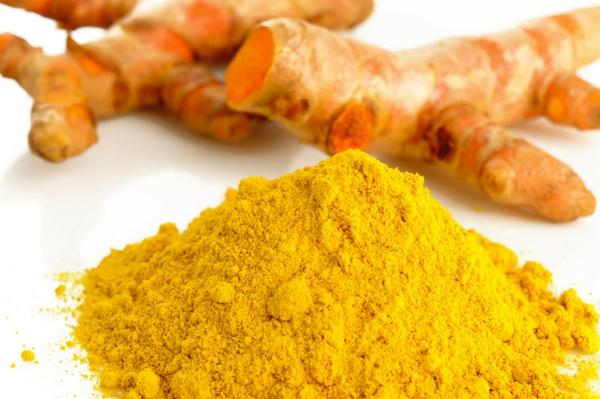Curcumin
Curcumin (synonyms: turmeric yellow, kurkum, INS No. 100(i)) is an orange-yellow crystalline powder. Minor amounts of oils and resins naturally occurring in turmeric may be present.
The origin of the plant Curcuma longa L., which belongs to Zingiberaceae family is India. The plant is distributed throughout tropical and subtropical regions of the world, being widely cultivated in southeast Asian countries. Turmeric, i.e., the ground rhizomes of Curcuma longa L., has a long history of use in food as a spice, mainly as an ingredient in many varieties of curry powders and sauces, where curcumin from turmeric is a main colouring substance.
Turmeric is a member of the Curcuma botanical group, which is part of the ginger family of herbs, the Zingiberaceae. The root and rhizome (underground stem) of the Curcuma longa L. plant is crushed and powdered into ground Turmeric. Ground Turmeric is used worldwide as a seasoning, the main ingredient in curry and as a source for Curcumin (Turmeric contains approximately 5% Curcumin) and its therapeutic effects.
USES
It is mostly used in the following fields:-
- Medical use
- Gastronomic used
- Cosmetics
- Condiment
- Anti Oxident
- Hemopreventive agent
- Immunomodirlation
- Hepatoprotective
- Neuroprotective
- Vision Protective
- Atherosclerosis
- Blood poperties /Cholesterol
- Wound healing
- Ulcers
- Antlfungal
- Antibacterial Phototoricity
- Antivenom
- Toricity
- Enzymatic Therapy etc.
Curcumin is an oil-soluble pigment, practically insoluble in water at acidic and neutral pH, and soluble in alkali. Preparations of water-soluble curcumin by incorporation into various surfactant micellar systems (e.g. sodium dodecyl sulfate, cetylpyridinium bromide, gelatine, polysaccharides, polyethylenglycol, cyclodextrins) have been reported. In solutions the principal colouring components of curcumin exhibit keto-enol tautomerism and, depending on the solvent, up to 95 percent are in the enol form.
MARKET SCENARIO OF TURMERIC
Turmeric (Curcuma Longa L.) the ancient and sacred spice of India known as ‘Indian Saffron’ is an important commercial spice crop grown in India. It is also known as the ‘Golden Spice of life” and is one of the most essential spices used as an important ingredient in culinary all over the world. Turmeric is a tropical perennial plant, native to India and Indonesia and is cultivated throughout the tropics around the world. It is an important commercial spice grown in India. It is part of Indian culture. Indian Turmeric is considered best in the world. Growing to a height of about three feet, it bears pairs of lance shaped leaves of alternate sides of the stem. At the base of the stem there is a knobby rhizome somewhat resembling ginger. It belongs to the family Zingiberaceae. Commercial part is rhizome or underground stem. Indian vernacular names are pasupu, haldi, manjal and kunyit in some Asian countries.
Turmeric is grown only in 6% of the total area under spices and condiments in India and India is the largest producer and exporter of turmeric in the world and accounts for 78% of world’s total production. Further, Turmeric is second largest foreign exchange earner among Indian spices. India consumes nearly 80% of turmeric.
Global Curcumin market is expected to reach USD 94.3 million by 2022, Therapeutic properties of curcumin such as anti-inflammatory and anti-oxidant make them ideally suited for use in food and medical application. The market is expected to witness significant growth in light of the growing consumer awareness regarding the above mentioned therapeutic properties. Increasing demand for herbal and ayurvedic skin care products is also expected to boost demand for curcumin over the forecast period. Curcumin or turmeric extracts are also gaining importance owing to the lower bioavailability of raw turmeric which is mostly consumed in food products.
Brief contents are:
INTRODUCTION
USES AND APPLICATION
PROPERTIES OF CURCUMIN
CHEMICAL CHARACTERIZATION OF CURCUMIN
CURCUMIN – THE YELLOW EXTRACT FROM TURMERIC
CHEMICAL COMPOSITION OF TURMERIC
PHARMACOLOGICAL ACTION OF TURMERIC AND ITS EXTRACT
FRAGRANCE AND FLAVOUR
MARKET SCENARIO OF TURMERIC
MARKET SURVEY
PRODUCTION OF CURCUMIN IN INDIA
PRESENT MANUFACTURERS OF CURCUMIN
PROCESS OUTLINE FOR CURCUMIN EXTRACTION
MANUFACTURING PROCESS OF CURCUMIN
Basic Plant and Machinery Required.
SALIENT FEATURE OF THE PROCESS
MANUFACTURING PROCESS DIAGRAM
TECHNICAL DETAILS FOR CURCUMIN EXTRACTION
EXTRACTION AND PROCESSING OF CURCUMIN
PLANT LAYOUT
PRINCIPLES OF PLANT LAYOUT
PLANT LOCATION FACTORS
EXPLANATION OF TERMS USED IN THE PROJECT REPORT
PROJECT IMPLEMENTATION SCHEDULES
SUPPLIERS OF RAW MATERIALS
SUPPLIERS OF PLANT AND MACHINERY
APPENDIX – A :
- COST OF PLANT ECONOMICS
- LAND & BUILDING
- PLANT AND MACHINERY
- FIXED CAPITAL INVESTMENT
- RAW MATERIAL
- SALARY AND WAGES
- UTILITIES AND OVERHEADS
- TOTAL WORKING CAPITAL
- COST OF PRODUCTION
- PROFITABILITY ANALYSIS
- BREAK EVEN POINT
- RESOURCES OF FINANCE
- INTEREST CHART
- DEPRECIATION CHART
- CASH FLOW STATEMENT
- PROJECTED BALANCE SHEET
The curcumin plant of capacity 20 Kg/Day needs 800 to 1200 sq. mtr land with plant and equipments cost approx/ 80 lacs INR, Rate of return 25% and BEP is 59%.




